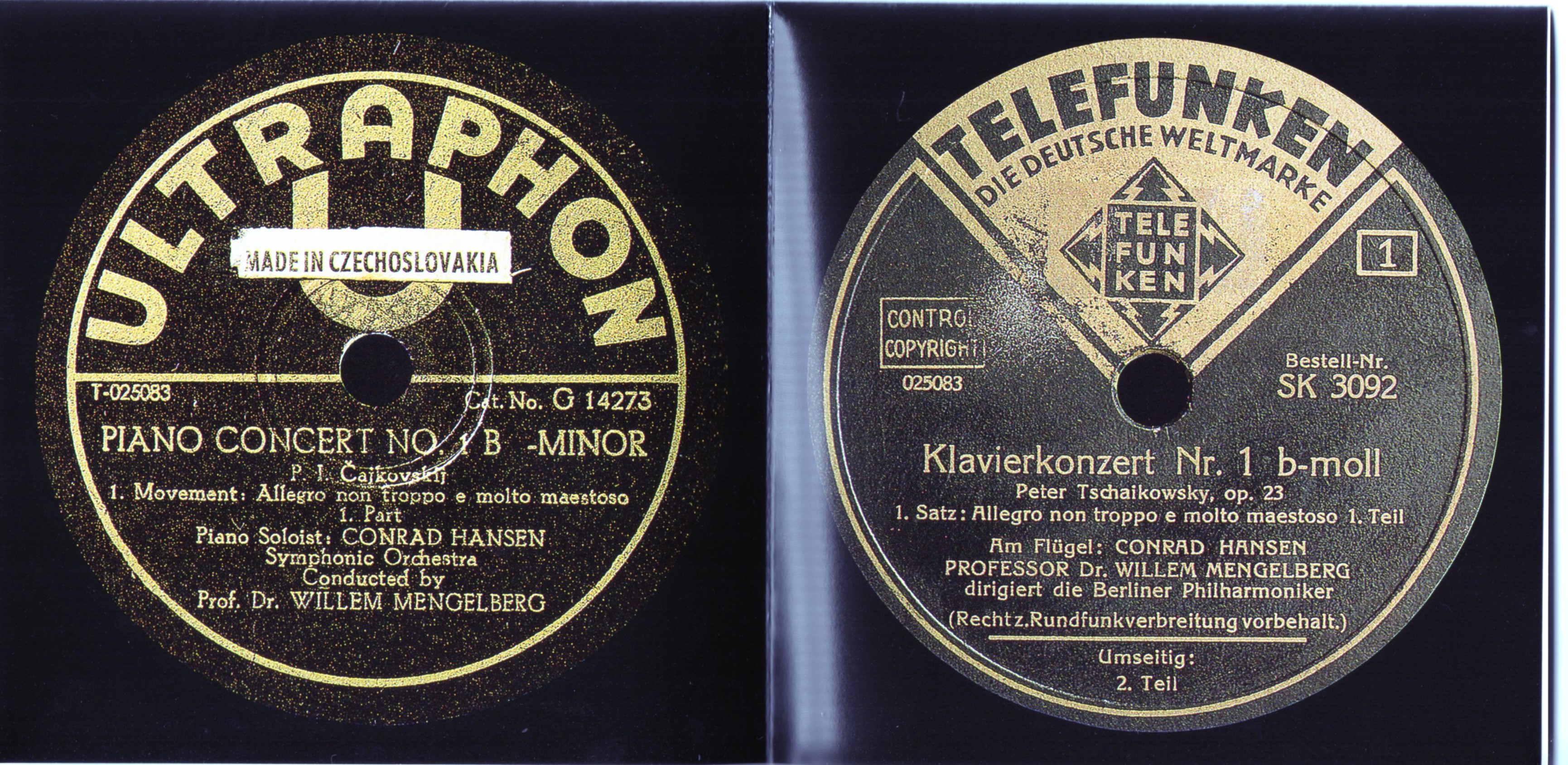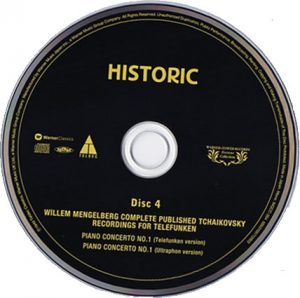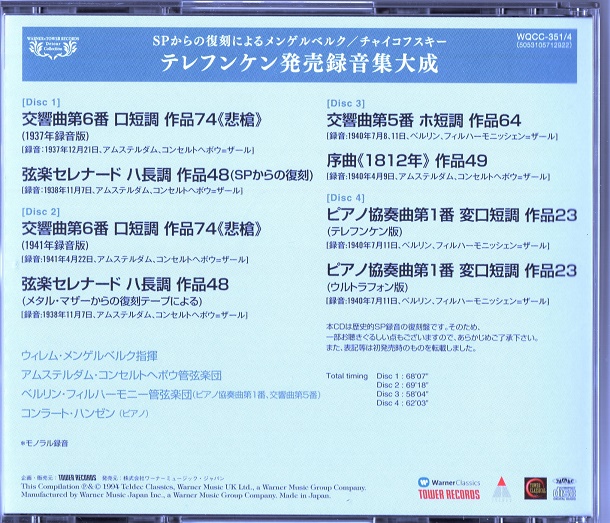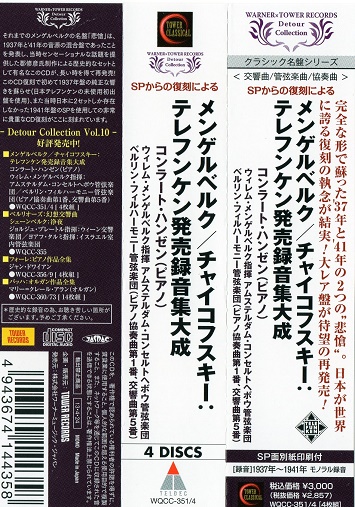
Conclusion
Two of the recording of [German Telefunken SP disk] and [Czechoslovakia Ultraphon SP disk] have mystery, the second half of the second movement is considered to be different recording.
CD data
CD model number
WQCC-354 (4th CD of 4 CD set)

CD label
Tower Records JAPAN (WARNER X TOWER RECORDS/Detour Collection)
Contents
<DISC4>
7. Piano Concerto No. 1 in B flat minor, Op. 23 (Telefunken version)
8. Piano Concerto No. 1 in B flat minor, Op. 23 (Ultraphon version)
Performance
Willem Mengelberg (conductor)
Berlin Philharmonic Orchestra
Conrad Hansen (piano)


Playing time
Piano Concerto No. 1 in B flat minor, Op. 23 (Telefunken version)
First movement 17:32 (4: 15 + 4:38 + 4:33 + 4:06)
The second movement 6:38 (3:01 + 3:37)
3rd movement 6:40 (2:34 + 4:06)
Piano Concerto No. 1 in B flat minor, Op. 23 (Ultraphon version)
First movement 17:33 (4: 15 + 4:39 + 4:34 + 4:05)
The second movement 6:38 (3:01 + 3:37)
3rd movement 6:40 (2:34 + 4:06)
Recording date
Piano Concerto No. 1 in B flat minor, Op. 23 (Telefunken version) and (Ultraphon version)
In 1940 July 11, the Berliner Philharmonie Konzertsaal
sponsored link
Mengelberg Tchaikovsky Piano Concerto No. 1: detailed comparison of Telefunken disk and Ultraphon disk
Description
In this CD, there are two of the recording has been recorded from SP type disk, the German-Telefunken SP and Czechoslovakia Ultraphon SP.
The SP of the German Telefunken and the SP of Czechoslovakia Ultraphon, although the sounds in the same way, dynamic feeling and, from the fact that to make the SP disk of the groove is different. This shows two recording are different recording or, at least the second movement of Telefunken is that it is a recording of another day, it has been pointed out in the booklet of the CD included.
In the booklet, this piano concerto and the Symphony No. 5, have been recorded on the same timingday at the Berliner Philharmonie Konzertsaal.
July 8 and 11, 1940: Symphony No. 5
July 11, 1940: Piano Concerto No. 1
On the other hand, in another book I have, it is different date as below,
July 8 to 10, 1940: Symphony No. 5
July 9, 1940: Piano Concerto No. 1
This suggests the possibility that the piano concerto has been recorded multiple times during July 8 to 11, 1940.
Or, perhaps the sound source was taken rehearsal that took place during this period.
Indeed, the second movement of the German-Telefunken and the Czech Republic, Slovakia Ultraphon have different impression.
Now, let’s compare the detailed data of the two recording as below!
Telefunken record: master number and the playing time of [German Telefunken SK-3092/95]
First movement 17:32 (4: 15 + 4:38 + 4:33 + 4:06)
Master 1 matrix number: 025083-I 4:15
Master 2 matrix number: 025084-I 4:38
Master 3 matrix number: 025085-I 4:33
Master 4 matrix number: 025086-I 4:06
Second movement 6:38 (3:01 + 3:37)
Master 5 matrix number: 025087-I 3:01
Master 6 matrix number: 025088-I 3:37
3rd movement 6:40 (2:34 + 4:06)
Master 7 matrix number: 025089 2:34 (Only Telefunken master 7 , there is no ending of “-I”)
Master 8 matrix number: 025090-I 4:06
Ultraphone Release: master number and the playing time of [Czech Republic Ultraphon G-14273/76]
First movement 17:33 (4: 15 + 4:39 + 4:34 + 4:05)
Master 1 Matrix number: 025083 4:15
Master 2 matrix number: 025084 4:39
Master 3 matrix number: 025085 4:34
Master 4 matrix number: 025086 4:05
Second movement 6:38 (3:01 + 3:37)
Master 5 matrix number: 025087 3:01
Master 6 matrix number: 025088 3:37
3rd movement 6:40 (2:34 + 4:06)
Master 7 matrix number: 025089 2:34
Master 8 matrix number: 025090 4:06
Record playing time by the Dutch Mengelberg Association
Record Date: July 9, 1940
First movement 17:52
Second movement 6:45
3rd movement 6:53
Waveform comparison of Telefunken and Ultraphon
First movement
Telefunken master 1 matrix number: 025083-I

Ultraphon master 1 matrix number: 025083

[Conclusion] Telefunken master 1 and Ultraphon master 1, which may be the same recording.
Telefunken master 2 matrix number: 025084-I

Ultraphon master 2 matrix number: 025084

[Conclusion] Telefunken master 2 and Ultraphon master 2, which may be the same recording.
Telefunken master 3 matrix number: 025085-I

Ultraphon master 3 matrix number: 025085

[Conclusion] Telefunken master 3 and Ultraphon master 3, which may be the same recording.
Telefunken master 4 matrix number: 025086-I

Ultraphon master 4 matrix number: 025086

[Conclusion] Telefunken master 4 and Ultraphon master 4, which may be the same recording.
Second movement
Telefunken master 5 matrix number: 025087-I

Ultraphon master 5 matrix number: 025087

[Conclusion] Telefunken master 5 and Ultraphon master 5, which may be the same recording.
Telefunken master 6 matrix number: 025088-I

Ultraphon master 6 matrix number: 025088

[Conclusion] Telefunken master 6 and Ultraphon master 6, is different recording.
The Telefunken has heard good accompaniment of the orchestra at about 19 seconds, but in the ultraphon, does not almost hear. At 24 seconds later, the accompaniment of the orchestra of both recording you can hear. In addition to the middle part, Ultraphon record has slowly near one second. But in the end, both end at approximately the same timing.
Defects on the performance: Telefunken has none, Ultraphon has none
Noise: Telefunken has almost no, there are large and small noises throughout the Ultraphon
Listening impression: Telefunken is more lyrical, Ultraphon is more dynamic (impression depends on the individual)
It is exactly my imagination,
The production recording was the Ultraphon master.
At the time of Telefunken master was created, the master 6 was replaced with the sound source that has been recorded in rehearsal, because of the noise level of the second movement (master 6) was very high.
Third movement
Telefunken master 7 matrix number: 025089

Ultraphon master 7 matrix number: 025089

[Conclusion] Telefunken master 7 and Ultraphon master 7, which may be the same recording.
Only Telefunken master 7 has not “-I” to the matrix number. The matrix number 025089 is the same as the Ultraphon master 7.
Other Telefunken master, it has “-I” to the matrix number.
The reason that can be assumed is two.
One is a mere chronicle mistake. Just forgot “-I” to the matrix number.
Another, other master is multiplied by some processing from the need of Telefunken side (master 6 replaced the sound source), only master 7, it did not have the need.
Above is exactly my imagination.
Telefunken master 8 matrix number: 025090-I

Ultraphon master 8 matrix number: 025090

[Conclusion] Telefunken master 8 and Ultraphon master 8, which may be the same recording.
Telefunken master 8 has a non-recording time band at the end.